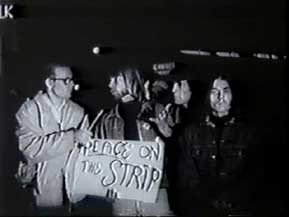By John Seal
April 26, 2003

The story: This is a documentary, so it's more of a theme than a story. Teenagers are rebelling worldwide, embracing sex, drugs, rock and roll, and dancing. Especially dancing.
The film: Patched together from footage shot in Britain, Italy, Japan, Sweden and the United States (the British footage is credited to Beatles director Richard Lester on IMDb, but he doesn't get an onscreen credit), Mondo Teeno is a relatively straight attempt to explain the younger generation to their confused and disturbed elders. The film starts out with glimpses of the Sunset Strip troubles - surely of prime concern to Mr. And Mrs. America in 1967- but quickly segues to other flash points of the period: Paris and Rome in 1966, Vienna, Panama, and Santo Domingo in 1965. None of this file footage is shown in context: it's merely used to establish a background of foment and unease. There's even a generous glimpse at the Mods and Rockers riots on Brighton Beach in April of 1965, which really only proves that teenagers were just as willing to rebel against each other as they were to rebel against their parents.
Having established its somewhat flimsy background, the film moves on to the meatier items on the menu. Coffee houses, motorcycles, leather jackets, and stove pipe jeans are each cited in turn by bemused narrator Burt Topper, who also pulls out a chestnut from Socrates to give the film a little intellectual substance: "Youth today love luxury. They have bad manners, contempt for authority, no respect for older people, and talk nonsense when they should be working. Young people do not stand up any longer when adults enter the room. They contradict their parents, talk too much in company, guzzle their food, lay their legs on the table and tyrannize their elders."
There are too many film fragments to list in this review, but some of the highlights include: staged footage of Japanese teens engaged in illicit sex (it's not as exciting as it sounds), Swedish teens cohabiting and buying sex books, a "pot party, roach party, mainliner" where kids take LSD-dosed sugar-cubes, and some out of place glimpses at some clearly over the hill motorcycle "enthusiasts," including one grizzled war vet with a prosthetic arm and hook. There's an odd claymation segment - again uncredited, but looking suspiciously like the work of Gumby creator Art Clokey - that features cavemen discovering the wheel. There's lots of lingerie, lots of dancing, and some decent music courtesy of surf legend Davie Allan (not to mention a title song by The Glass House, probably a group of Mike Curb-associated session musicians).
The crew: Produced, written, and directed by Norman T. Herman (the producer of 1970s Bloody Mamaand cult favorite Frogs), Mondo Teeno papers over its low, low budget with copious additional footage shot by Richard Lester and Eriprando Visconti (nephew of famed director Luchino Visconti). True to expectations, the British and Italian footage is the best, especially the interview with a 17-year-old Ilford prostitute and a homosexual Italian boy (who speaks in his native language sans subtitles). The somewhat unctuous narration is by Burt Topper, a producer-director who spent most of his career working for Sam Arkoff and Jim Nicholson at AIP. Davie Allan's music is excellent, though it's mostly cribbed from his other AIP soundtracks.
Nostalgia value: Oh, boy, yes. A time capsule of adult fears; little did those same adults realize that, with the Chicago Democratic Convention, Kent State, and the Manson Family all around the corner, things were about to get much, much worse. As a result, Mondo Teeno plays a lot like the cautionary juvenile delinquency films of the 1950s, scolding moderately, whilst trying to remind Mom and Dad of their own wilder days courtesy footage of '30s dance marathons and goofy guys in zoot suits. The film presciently predicts the continuing spread of consumer culture, and interestingly points out that Japanese women were leading the way in cosmetic surgery, including something called "surgical re-flowering." Ouch. The film ends with the classic carny come-on, a new example of the birth of a baby footage that had shocked folks twenty years earlier in 1947's Mom and Dad, as a reminder of the 'circle of life'. Taken as a whole, you can't beat Mondo Teeno's combination of frugging teens, outrageous hairstyles, and mod, mod fashions.
The print: For what it is, it looks really, really good. Some of the stock footage is damaged, but the staged scenes look great. There's some slight letter-boxing (1.66:1) during the Italian sequences, but the rest of the film is comfortably full frame.
DVD prognosis: Something Weird still has this in their video catalogue, and it seems like a perfect choice for one of their terrific double features.
Ratings:
Film: B. Mondo Teeno manages to rein in the outrage and nobly tries to present its material in a dispassionate manner. By and large it succeeds, though it occasionally tips into full-blown exploitation mode.
Print: B+. All things considered, it couldn't look much better.
DVD worthiness: B. It's no classic, but it would look great side-by-side with another teensploitation flick. Anyone got a copy of Battle of the Mods handy?
